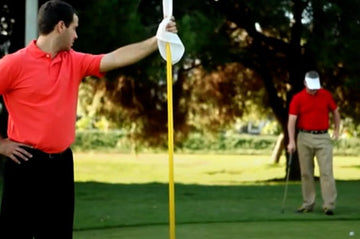 Typical OB markings and stakes[/caption]
I know there are many Frogger readers who are beginner golfers, and many experienced golfers who still struggle with the rules. The rules can be complicated to say the least. Today we will discuss what happens when we unfortunately go "out of bounds."
White stakes, white lines or fences typically denote the golf course boundaries. If a ball travels outside of the white stakes the ball has gone out of bounds. Don't confuse white "ground under repair" lines with white OB lines. GUR lines will typically be within a hole, circling or marking areas which are damaged or perhaps being re-sodded.
A ball is deemed to be out of bounds when ALL of the ball lies OB. If your ball comes to rest on the OB line, but part of it is touching in bounds, you are in bounds and may hit the shot from there. You may stand out of bounds to hit a ball which lies in bounds.
OB Options
There are not multiple options for OB situations like there are for lateral hazard situations. There is only one option in fact. You must play a ball, under penalty of one stroke, as nearly as possible to the spot from which the original ball was last played. This is called a "stroke and distance" penalty, and they're not fun. If you hit a tee shot and it goes out of bounds, you may re-tee the penalty shot.
Typical OB markings and stakes[/caption]
I know there are many Frogger readers who are beginner golfers, and many experienced golfers who still struggle with the rules. The rules can be complicated to say the least. Today we will discuss what happens when we unfortunately go "out of bounds."
White stakes, white lines or fences typically denote the golf course boundaries. If a ball travels outside of the white stakes the ball has gone out of bounds. Don't confuse white "ground under repair" lines with white OB lines. GUR lines will typically be within a hole, circling or marking areas which are damaged or perhaps being re-sodded.
A ball is deemed to be out of bounds when ALL of the ball lies OB. If your ball comes to rest on the OB line, but part of it is touching in bounds, you are in bounds and may hit the shot from there. You may stand out of bounds to hit a ball which lies in bounds.
OB Options
There are not multiple options for OB situations like there are for lateral hazard situations. There is only one option in fact. You must play a ball, under penalty of one stroke, as nearly as possible to the spot from which the original ball was last played. This is called a "stroke and distance" penalty, and they're not fun. If you hit a tee shot and it goes out of bounds, you may re-tee the penalty shot.
Golf Rules: Out of Bounds
[caption id="attachment_2177" align="alignright" width="300"] Typical OB markings and stakes[/caption]
I know there are many Frogger readers who are beginner golfers, and many experienced golfers who still struggle with the rules. The rules can be complicated to say the least. Today we will discuss what happens when we unfortunately go "out of bounds."
White stakes, white lines or fences typically denote the golf course boundaries. If a ball travels outside of the white stakes the ball has gone out of bounds. Don't confuse white "ground under repair" lines with white OB lines. GUR lines will typically be within a hole, circling or marking areas which are damaged or perhaps being re-sodded.
A ball is deemed to be out of bounds when ALL of the ball lies OB. If your ball comes to rest on the OB line, but part of it is touching in bounds, you are in bounds and may hit the shot from there. You may stand out of bounds to hit a ball which lies in bounds.
OB Options
There are not multiple options for OB situations like there are for lateral hazard situations. There is only one option in fact. You must play a ball, under penalty of one stroke, as nearly as possible to the spot from which the original ball was last played. This is called a "stroke and distance" penalty, and they're not fun. If you hit a tee shot and it goes out of bounds, you may re-tee the penalty shot.
Typical OB markings and stakes[/caption]
I know there are many Frogger readers who are beginner golfers, and many experienced golfers who still struggle with the rules. The rules can be complicated to say the least. Today we will discuss what happens when we unfortunately go "out of bounds."
White stakes, white lines or fences typically denote the golf course boundaries. If a ball travels outside of the white stakes the ball has gone out of bounds. Don't confuse white "ground under repair" lines with white OB lines. GUR lines will typically be within a hole, circling or marking areas which are damaged or perhaps being re-sodded.
A ball is deemed to be out of bounds when ALL of the ball lies OB. If your ball comes to rest on the OB line, but part of it is touching in bounds, you are in bounds and may hit the shot from there. You may stand out of bounds to hit a ball which lies in bounds.
OB Options
There are not multiple options for OB situations like there are for lateral hazard situations. There is only one option in fact. You must play a ball, under penalty of one stroke, as nearly as possible to the spot from which the original ball was last played. This is called a "stroke and distance" penalty, and they're not fun. If you hit a tee shot and it goes out of bounds, you may re-tee the penalty shot.
 Typical OB markings and stakes[/caption]
I know there are many Frogger readers who are beginner golfers, and many experienced golfers who still struggle with the rules. The rules can be complicated to say the least. Today we will discuss what happens when we unfortunately go "out of bounds."
White stakes, white lines or fences typically denote the golf course boundaries. If a ball travels outside of the white stakes the ball has gone out of bounds. Don't confuse white "ground under repair" lines with white OB lines. GUR lines will typically be within a hole, circling or marking areas which are damaged or perhaps being re-sodded.
A ball is deemed to be out of bounds when ALL of the ball lies OB. If your ball comes to rest on the OB line, but part of it is touching in bounds, you are in bounds and may hit the shot from there. You may stand out of bounds to hit a ball which lies in bounds.
OB Options
There are not multiple options for OB situations like there are for lateral hazard situations. There is only one option in fact. You must play a ball, under penalty of one stroke, as nearly as possible to the spot from which the original ball was last played. This is called a "stroke and distance" penalty, and they're not fun. If you hit a tee shot and it goes out of bounds, you may re-tee the penalty shot.
Typical OB markings and stakes[/caption]
I know there are many Frogger readers who are beginner golfers, and many experienced golfers who still struggle with the rules. The rules can be complicated to say the least. Today we will discuss what happens when we unfortunately go "out of bounds."
White stakes, white lines or fences typically denote the golf course boundaries. If a ball travels outside of the white stakes the ball has gone out of bounds. Don't confuse white "ground under repair" lines with white OB lines. GUR lines will typically be within a hole, circling or marking areas which are damaged or perhaps being re-sodded.
A ball is deemed to be out of bounds when ALL of the ball lies OB. If your ball comes to rest on the OB line, but part of it is touching in bounds, you are in bounds and may hit the shot from there. You may stand out of bounds to hit a ball which lies in bounds.
OB Options
There are not multiple options for OB situations like there are for lateral hazard situations. There is only one option in fact. You must play a ball, under penalty of one stroke, as nearly as possible to the spot from which the original ball was last played. This is called a "stroke and distance" penalty, and they're not fun. If you hit a tee shot and it goes out of bounds, you may re-tee the penalty shot.



























